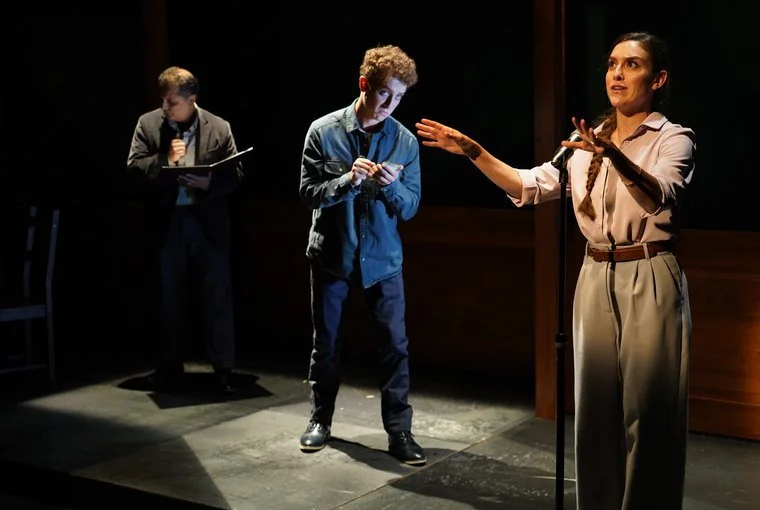This Much I Know
Written by Jonathan Spector; Directed by Hayley Finn
59E59 Theatres | Theater A, 59 East 59th Street, NY, NY
September 20 - October 19, 2025
Photo Credit: Carol Resegg
There are kaleidoscopic marvels awaiting the inquisitive mind at Theater J’s production of Jonathan Spector’s This Much I Know. It unfolds not merely as a play, but as an exhilarating act of cognitive seduction. Rarely does a production so deftly blur the boundaries between lecture hall and theatrical stage, between didacticism and drama, between memory and mirage. It is, in fact, a work that boldly dares to dramatize the mechanics of thought itself.
Structured as a two-act, three-actor masterclass in psychological inquiry and philosophical inquiry alike, This Much I Know operates with a formal inventiveness that is as dazzling as it is disarming. At its core is Professor Lukesh, a psychologist played with immeasurable warmth and sardonic charm by the remarkable Firdous Bamji. From the moment he greets the audience — winking through a wry retooling of the pre-show phone announcement — Bamji ensnares us with a charisma that’s one part TED Talk titan, one part metaphysical guide. But do not mistake the professor’s affability for simplicity; his is a mind — and a performance — that dances nimbly across the synaptic intersections of cognition, identity, belief, and trauma.
Lukesh’s intellectual provocations form the spine of the play, but its soul lies in the fragmented, refracted narratives that spiral outward from his lectures — stories that may at first appear disparate, only to later resolve into a mosaic of emotional and ideological resonance. Or not. Part of the genius here is that Spector resists the temptation to impose clean narrative closure. Instead, he trusts his audience to experience the text as we experience life: as an unresolved sequence of moments we long to make sense of, even when meaning proves elusive.
The scenic design by Misha Kachman is itself a marvel of cognitive metaphor — a dynamic construction of sliding chalkboard panels and aged wood that never lets us forget the play’s academic conceit, even as it transports us fluidly from one psychological dimension to another. Transitions become transformations, mirroring the slippery fluidity of memory and perception. In a single, extraordinary example, the luminous Dani Stoller, who begins as Natalya — Lukesh’s estranged wife — dissolves into a compelling embodiment of Joseph Stalin’s daughter, without so much as a costume change. It is a metamorphosis not just of persona, but of psychic terrain.
With enigmatic abruptness, Natalya’s departure from her marriage — unannounced, unexplained, and seemingly unprovoked — casts a pall over Lukesh’s inner world, leaving him groping for clarity in the very psychological fog he so often seeks to dispel in others. Her vanishing is not a narrative twist so much as an existential rupture, a void into which Lukesh’s intellect collapses, leaving him ironically at his most composed only when cloaked in the orderly confines of the lecture hall. There, amid the chalk-dusted rationality of academia, his personal bewilderment finds its only salve — the illusion of control through pedagogy.
As the story gradually unfolds, we learn that Natalya’s flight is far from aimless; rather, it is a deeply personal quest, a genealogical excavation that leads her across temporal and geographic boundaries to uncover a tenuous familial connection to none other than Svetlana Alliluyeva, Stalin’s sole daughter. In Spector’s hands, this historical figure becomes more than a footnote to tyranny — she is a richly symbolic presence, a living embodiment of ideological disinheritance, of the soul’s desperate yearning to extricate itself from the monstrous mythologies of lineage and belief.
Stoller renders both women — Natalya and Svetlana — with astonishing agility and emotional precision, folding one identity into the other with the finesse of an actor not merely portraying characters, but channeling cognitive dissonance itself. As Svetlana, Stoller captures the brittle glamour, internal conflict, and steely moral reckoning of a woman born into absolute power yet determined to renounce its most poisonous legacies. Her performance becomes, in effect, a living case study in epistemic transformation — the long, arduous, and deeply human process of rethinking inherited narratives, accepting culpability, and rewriting the self.
In the Svetlana sequences, the play gives corporeal form to its central philosophical preoccupations: What does it take to truly change one’s mind? To disentangle belief from blood? And what becomes of the self when the stories we’ve been told — and told ourselves — begin to fracture under the weight of inconvenient truths? Stoller’s embodiment of this historic yet hauntingly relatable woman offers no easy answers, but in its complexity lies the very essence of the play’s intellectual and emotional force.
Costume designer Danielle Preston wisely eschews theatrical flourishes in favor of sleek, minimalist silhouettes that allow actors to pivot swiftly between characters while maintaining continuity of presence — and Stoller’s quicksilver shifts in dialect, bearing, and tone are as thrilling as they are intellectually provocative. The character of Svetlana, as imagined by Spector, is not merely historical — she is allegorical, an emissary from the outer reaches of inherited trauma, the human cost of ideological inheritance. Her presence resonates chillingly against the narrative of Harold, a brilliant but tormented student whose father — a celebrated white nationalist — looms as his own inescapable specter. Ethan J. Miller delivers a performance of raw, searching honesty, capturing a young man on the knife-edge between critical inquiry and indoctrinated allegiance.
The play is fascinated by how we come to believe what we believe, how our minds cling to false narratives even in the face of overwhelming contradiction. “Sticky,” as Lukesh puts it. And indeed, few ideas are stickier — or more chilling — than those voiced through a stunning projection sequence (by the visual genius Mona Kasra), in which black-and-white portraits of Stalin and Harold’s father literally speak through Bamji’s amplified voice, an effect as haunting as it is theatrically inventive. Sound designer Sarah O’Halloran enhances the unease, layering these ghostly voices with a thrum of ideological dread that lingers long after the scenes end.
And lighting designer Colin K. Bills, with his masterful command of illumination as both mood-setter and narrative guide, bathes each scene transition in a luminous clarity that feels less like a mere shift in location and more like a metaphysical recalibration. His lighting does not simply brighten or dim; it thinks alongside the play, responding with sensitivity and nuance to the shifting terrains of time, memory, and psychological space. Whether gently washing the stage in a cerebral glow or plunging it into shadowed ambiguity, Bills ensures that every change in scene carries the visual poetry and emotional intelligence the script demands. The result is a sequence of transitions that are not only seamless but imbued with a kind of radiant dramaturgy — as if the very light itself were conspiring with the text to illuminate the recesses of the mind.
At the helm is director Hayley Finn, whose directorial precision is matched only by her sensitivity to the play’s cerebral intricacies. With a keen eye for rhythm and texture, Finn orchestrates the evening like a symphony of cognition, allowing moments of philosophical abstraction to land with emotional weight. Of particular brilliance is her attention to the actors’ physical expressivity — fingers, hands, postures all choreographed with subtle intent, bodies becoming conduits for the very ideas the play interrogates. It's as if the characters’ gestures themselves are trying to reach beyond the limits of spoken thought.
By intermission, one might find oneself dizzy — not from confusion, but from the sheer intellectual altitude the play dares to ascend. And yet, Spector never forgets that drama lives in the human. Late in Act II, Lukesh recounts a deceptively simple anecdote about intuitive decision-making — a moment that lands with quietly shattering effect. It is a perfect distillation of the play’s core paradox: that for all our lofty rationalism, our lives are often governed by unknowable instincts and unprovable beliefs.
In one of the play’s most searing insights, Lukesh reminds us that the brain is a machine for projecting into hypothetical futures. This Much I Know is just such a machine — an engine of what-ifs, of imagined lives and alternate selves, of fractured memories and dangerous certainties. It is not always easy to parse, nor is it meant to be. As Svetlana, with bleak eloquence, observes: “The less you know, the more certain you are.”
The irony, of course, is that by the end of this exhilarating theatrical experiment, you may feel less certain of what you know — but infinitely more alive in the questions you carry out with you into the night. This Much I Know insists that we peer through every available lens, that we entertain, as the professor might say, “all sides now.” But this is no static exercise in intellectual balance; it is a whirring, high-velocity express train barreling through the intricate, often contradictory terrain of the human mind. Certainties blur, and what initially appears cut-and-dried quickly reveals itself to be richly marbled with ambiguity. Belief, memory, identity—none are fixed; all are in flux. And yet, for all its heady examinations of cognition and epistemology, this play is not content to live solely in the corridors of the cerebral. Woven through its mental labyrinth is a quieter, more tender thread: a love story, both fractured and fervent. For beneath the theories and thought experiments lies the subtler, more elusive knowledge that the heart harbors—a knowledge that cannot be diagrammed on a chalkboard or justified by peer-reviewed studies, but which nonetheless asserts itself with irrefutable force.
That the play dares to unite the rigorous intellect of psychological inquiry with the aching vulnerabilities of human connection is, perhaps, its most radical gesture. It suggests that amid the tangle of facts and fallacies, despite the fallibility of memory and the slipperiness of truth, we remain tethered to one another by something less quantifiable but no less real: love, in all its imperfect, redemptive forms. And so, in its final moments, the play offers not resolution but reconciliation. Not answers, but acknowledgment. And that, too, is a kind of happy ending—not the tidy, fairy-tale kind, but one born of hard-won understanding, where head and heart finally find themselves, however briefly, in harmony.
Click HERE for tickets.
Review by Tony Marinelli.
Published by Theatre Beyond Broadway on October 4, 2025. All rights reserved.




